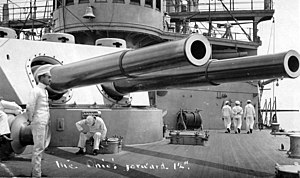The 12"/40 caliber gun (spoken as "twelve-inch-forty--caliber") were used for the primary batteries of the United States Navy's last class of monitors and the Maine-class and Virginia-class pre-dreadnought battleships.[1]
| 12"/40 caliber Mark 3 and Mark 4 | |
|---|---|
 View of Ohio and her forward 12"/40 caliber guns in the Mark 4 turret in 1916. | |
| Type | Naval gun |
| Place of origin | United States |
| Service history | |
| In service | 1902 |
| Used by | United States Navy |
| Wars | World War I |
| Production history | |
| Designer | Bureau of Ordnance |
| Designed | 1899 |
| Manufacturer | U.S. Naval Gun Factory |
| No. built |
|
| Variants | Mark 3 and Mark 4 |
| Specifications | |
| Mass |
|
| Barrel length | 40 ft 0 in (12.19 m) bore (40 calibers) |
| Shell | 870 lb (390 kg) armor-piercing |
| Caliber | 12 in (305 mm) |
| Elevation |
|
| Traverse | −150° to +150° |
| Rate of fire |
|
| Muzzle velocity |
|
| Effective firing range | 19,000 yd (17,374 m) at 15.5° elevation |
Design
editThe 12-inch (305 mm)/40 caliber gun was developed after the Spanish–American War to use the new smokeless powder that had recently been adopted by the Navy. The Mark 3, gun Nos. 15–48 and 50–56, was constructed of tube, jacket, and eight hoops. It was found that the early guns suffered from excessive bore erosion, in an attempt to fix this the Navy reduced the propellant charges to reduce the muzzle velocity, because of this the Mark 4, gun Nos. 49, 58–60, 150–154, and 179, was similar to the Mark 3 but with a smaller chamber for the reduced propellant charge.[1][2]
Service history
editThe guns mounted in the Virginia-class battleships were in an unusual two-level turret with the 8-inch (203 mm)/45 caliber guns on top of the larger 12-inch guns. This arrangement ultimately proved unsuccessful but helped the Navy in the successful development of superfiring turrets later used in the dreadnought South Carolina.[1]
Incident
editGun No. 49, while testing powder at the Naval Proving Ground, had the entire muzzle and chase blow off. The board appointed to investigate came to the conclusion that the new powder, while performing properly, caused a pressure along the chase that was dangerously close to the strength curve. It was decided that when the guns were withdrawn to be relined they would add an additional hoop that extended to the muzzle would be placed on the chase.[3]
Naval Service
edit| Ship | Gun Installed | Gun Mount |
|---|---|---|
| USS Arkansas (BM-7) | Mark 3 or 4: 12"/40 caliber | Mark 4: 1 × twin turrets |
| USS Nevada (BM-8) | Mark 3 or 4: 12"/40 caliber | Mark 4: 1 × twin turrets |
| USS Florida (BM-9) | Mark 3 or 4: 12"/40 caliber | Mark 4: 1 × twin turrets |
| USS Wyoming (BM-10) | Mark 3 or 4: 12"/40 caliber | Mark 4: 1 × twin turrets |
| USS Maine (BB-10) | Mark 3 or 4: 12"/40 caliber | Mark 4: 2 × twin turrets |
| USS Missouri (BB-11) | Mark 3 or 4: 12"/40 caliber | Mark 4: 2 × twin turrets |
| USS Ohio (BB-12) | Mark 3 or 4: 12"/40 caliber | Mark 4: 2 × twin turrets |
| USS Virginia (BB-13) | Mark 3 or 4: 12"/40 caliber | Mark 5: 2 × dual-caliber turrets |
| USS Nebraska (BB-14) | Mark 3 or 4: 12"/40 caliber | Mark 5: 2 × dual-caliber turrets |
| USS Georgia (BB-15) | Mark 3 or 4: 12"/40 caliber | Mark 5: 2 × dual-caliber turrets |
| USS New Jersey (BB-16) | Mark 3 or 4: 12"/40 caliber | Mark 5: 2 × dual-caliber turrets |
| USS Rhode Island (BB-17) | Mark 3 or 4: 12"/40 caliber | Mark 5: 2 × dual-caliber turrets |
Notes
edit- ^ Friedman 2011.
- ^ Mason 1905, p. 14.
References
edit- Books
- Friedman, Norman (2011). Naval Weapons of World War One. Seaforth Publishing. ISBN 978-1-84832-100-7.
- Mason, Newton E. (1 October 1905). Report of the Chief of the Bureau of Ordnance to the Secretary of the Navy. Washington, D.C.: Government Printing Office. Retrieved 13 October 2016.
- Online sources
- "United States of America 12"/40 (30.5 cm) Mark 3 and Mark 4". Navweaps. 19 July 2016. Retrieved 13 October 2016.
External links
edit